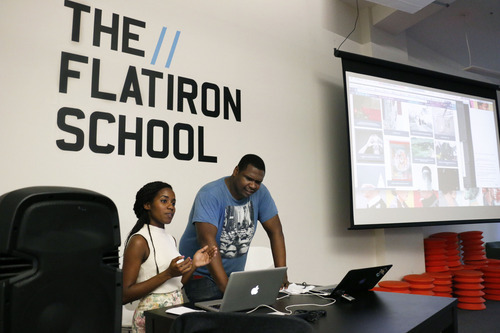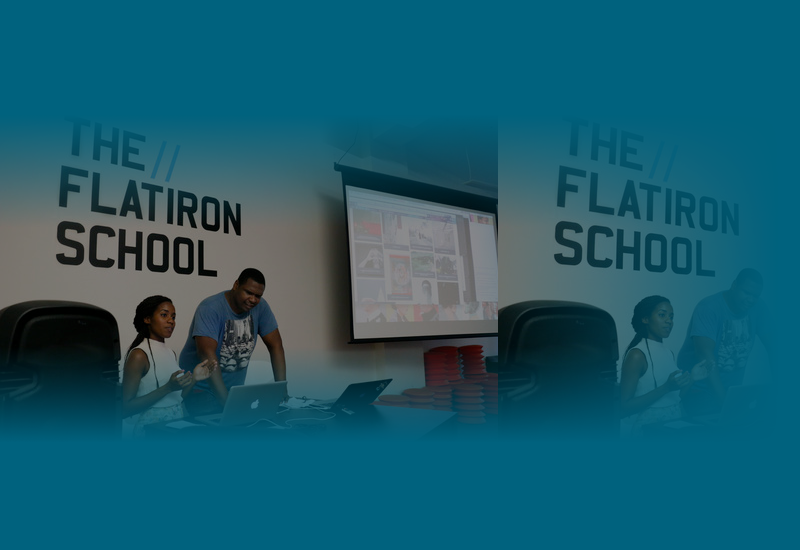Christine Beaubrun was a student in Flatiron School’s NYC Web Development Fellowship. Now she works as a developer at Intel. She originally posted this story in her blog.
A man and a woman told me on two separate occasions “You don’t look like a programmer” and “You’re too creative to be a programmer.” Though their words were very discouraging to hear, at the time I understood their logic. Haitian born, Brooklyn raised, I graduated from Smith College with a Bachelor’s in Studio Art and a concentration in drawing.
After graduation I worked at restaurants and a coffee bar before moving to Neuehouse, a members-only workspace for people in creative industries, where I worked as a host. My responsibilities were simple: keep members’ spirits high and the space clean, but I knew I could be useful on their design team. I could connect and communicate with people using the web and art.
A month into my job at Neuehouse, I started an Adobe Creative Suite class. Balancing school and work was taxing, but I knew my efforts would eventually culminate in an incredible project. The idea came in September, at the end of class, fueled by my desire to answer the question “What is Neuehouse?” Armed with my new Adobe skills, a Canon Rebel T1 camera, and my tricked out Macbook Pro, I set out to capture the unique personalities of the Neuehouse staff. I wanted to explore something small with the potential to reveal a lot, and decided shoes would be my subject. I photographed fifty employees’ shoes and interviewed them to find out what filled those shoes. The project, now a magazine, was titled “The Working Soles of Neuehouse.”
“Here was an opportunity to be challenged, pushed, and prodded to be the best programmer possible.”
As I worked on the magazine, I realize I wanted a career that combined design with technology so I began applying to Parsons Paris MFA program in Design and Technology. Around the same time, a friend introduced me to the Flatiron School Fellowship and I knew I had stumbled on a goldmine. Here was an opportunity to be challenged, pushed, and prodded to be the best programmer possible. At the Flatiron School, I would have access to developers from whom I can learn. I refused to settle for anything less than admission. I worked on the magazine, my Parsons and Flatiron School Fellowship application, while attending Flatiron School meetups, and learning the programming language Ruby. In January, I finished the magazine and submitted my Parsons application. The magazine was incredibly successful and a print version soon followed. Two months later, I had an interview at Flatiron School. Four interviews and a coding quiz later, I was admitted as a fellow. That moment I decided, admittance to Parsons or not, I would become a full-stack developer.

One of the first problems I solved while at Flatiron School was redesigning the user experience of selecting a museum exhibit. I’m always plagued by the search for museums to visit and the website navigation required to decide on an exhibition. The solution: gather all the data surrounding museums’ exhibitions in one place. I built “The Exhibitionist” in just two weeks. It is a web application that delivers current exhibitions at the Museum of Modern Art, the Metropolitan Museum, the Guggenheim museum, the Brooklyn Museum, and the Studio Museum in Harlem all on one page. I am actively working to add more museums.
“What I love most about being a developer is the endless ability to create and produce solutions with worldwide impact.”
What I love most about being a developer is the endless ability to create and produce solutions with worldwide impact. My programming skills enable me to use my imagination to solve other people’s problems. My knowledge enables me to learn new languages, solve old problems in new ways, and work collaboratively to create web applications that are beneficial to people across varying backgrounds, industries, and continents. The only thing I wish I had known when I started is that yes, programming seems difficult at first but becomes easier over time. Overcoming that first hurdle is paramount. After deploying “The Exhibitionist,” I finally understood what it meant to be a programmer and why it is worth fighting through every frustration.
“We as a community must work to actively support, mentor, and encourage programmers who are of color and identify as women.”
We as a community must work to actively support, mentor, and encourage programmers who are of color and identify as women. I am thankful to have had great friends who are programmers. They constantly told me, “Yes you can program and you should program.” Even when programming was hard, those same friends told me again, “Yes, programming is hard but you can and will do it.” This marginalized group of programmers needs the support and encouragement of a community who believes in their capabilities. We need to hear early and often, “Yes, you can program.”
Interested in starting your own journey to a tech career? Start your coding education with Flatiron School on Learn.
Written byFLATIRON SCHOOL
Make yourself useful.

